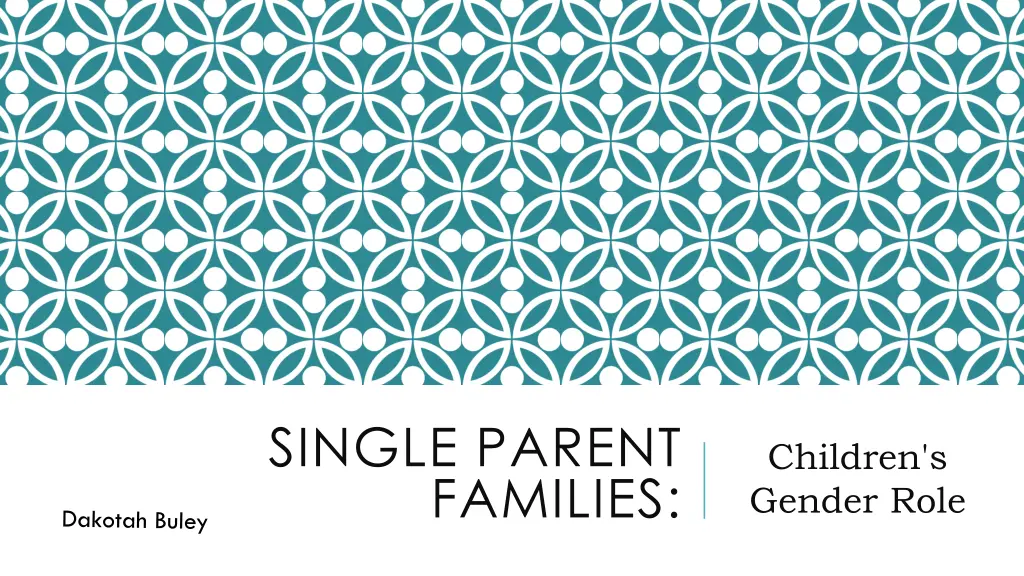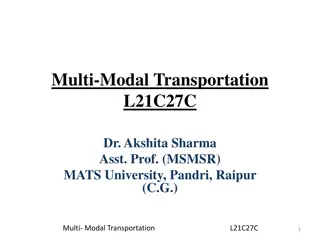
Gender Roles in Single-Parent Families: Impact on Children
Explore how children in single-parent families learn and adopt gender roles, the effects of single-parent households on traditional sex roles, and the development of nontraditional characteristics in both single mothers and fathers. Learn how these experiences shape children's perceptions and behaviors in society.
Download Presentation

Please find below an Image/Link to download the presentation.
The content on the website is provided AS IS for your information and personal use only. It may not be sold, licensed, or shared on other websites without obtaining consent from the author. If you encounter any issues during the download, it is possible that the publisher has removed the file from their server.
You are allowed to download the files provided on this website for personal or commercial use, subject to the condition that they are used lawfully. All files are the property of their respective owners.
The content on the website is provided AS IS for your information and personal use only. It may not be sold, licensed, or shared on other websites without obtaining consent from the author.
E N D
Presentation Transcript
SINGLE PARENT FAMILIES: Children's Gender Role
CHILDREN'S OBSERVATIONS Children learn the categorization of traits as either masculine or feminine by observing their parents closely. "Children learn that women and men (should) act differently when they observe that mothers spend more time on care-giving and fathers, on leisure activities with their children. From this perspective, parents should pass their attitudes about gender roles to their children, resulting in congruence between parents and children s gender role attitudes" (Marks).
EFFECT OF SINGLE PARENT HOUSEHOLDS Children in traditional homes with a mother and father... "In a stable two-parent household, the children will learn traditional sex roles from interacting with their father and watching their mother and father interact with each other" (Russel and Ellis). However, children in homes with only one parent... The father, traditionally the provider, can take on the role of caretaker for children just like the mother, traditionally the caretaker, can take on the role of provider for her family. With the development of new characteristics outside the scope of tradition, the role in the household that is left open because of the absent parent can be filled by the remaining parent.
DEBORAH KALAS'S PHOTOGRAPHY Photography Retrospective: Blast From the Past
LEARNING GENDERED CHARACTERISTICS FROM A SINGLE PARENT "I see her doing things around the house I know a man should be here doing, but she will find way to show me that we can go on without a man in the house. I look up to her for showing me that she can do things without any help" (Fazio).
EXAMPLES Nontraditional Characteristics Children Observe in a Single Mother By taking on the role as the provider, protector, and sometimes even the handy- man, the single mother must become assertive, strong, and determined. Nontraditional Characteristics Children Observe in a Single Father In becoming the primary caretaker for his daughters, the father develops nurturing characteristics, such as empathy and gentleness, that are not traditionally masculine.
ADVANTAGES FOR ANDROGYNOUS CHILDREN "Androgynous individuals should be psychologically healthier and better suited to succeed in our modern day society, and non- androgynous individuals may be restricted in the range of behaviors in which they can comfortably participate" (Russel and Ellis). The children that grow up in these single- parent households are very often androgynous and able to participate in behaviors that are outside the traditional scope of their gender. Concurrently, the need for people who can take on duties and portray characteristics outside of their traditional gender role is increasing due to the advancement of equality between men and women.
CONCLUSION Children in single parent homes have different understandings of characteristics being either masculine or feminine because of their parent having to take on the role of both a mother and a father.
WORKS CITED - DePaulo, Bella Ph.D. "10 Ways the Children of Single Parents Defy All Stereotypes." Psychology Today, 15 July 2015, https://www.psychologytoday.com/blog/living-single/201507/10-ways-the-children-single-parents-defy-all-stereotypes. Accessed 27 March 2017. - Fazio, Lauren. "An Open Letter to Single Mothers Who Play Both Roles." Odyssey, 11 January 2016, https://www.theodysseyonline.com/open-letter-single-mothers-who-play-both-roles. Accessed 10 April 2017. - Kalas, Deborah. Photography Retrospective: Blast From the Past. Deborah Kalas Photography Studio, 20 June 2013, http://deborahkalasphotography.com/photography-retrospective-blast-from-the-past/. Accessed 27 March 2017. - Kincaid, Jamaica. "Girl." Rereading America: Cultural Contexts for Critical Thinking and Writing, edited by Gary --- Colombo, Robert Cullen, and Bonnie Lisle, Bedford/St. Martin's, 2016, pp. 469-470. - Marks, Jaime, Lam Chun Bun, and Susan M. McHale. Family Patterns of Gender Role Attitudes. Sex roles 61.3-4 (2009): 221 234. PMC. Web. 27 Mar. 2017. - Risman, Barbara J. and Kyung Park. "Just the Two of Us: Parent-Child Relationships in Single-Parent Homes." Journal of Marriage & Family, vol. 50, no. 4, Nov. 1988, pp. 1049-1062. EBSCOhost, umiss.idm.oclc.org/login?url=http://search.ebscohost.com/login.aspx?direct=true&db=fmh&AN=5282209&site=ehost- live&scope=site. - Russell, C. Denise and Jon B. Ellis. "Sex-Role Development in Single Parent Households." Social Behavior & Personality: An International Journal, vol. 19, no. 1, Feb. 1991, pp. 5-9. EBSCOhost, umiss.idm.oclc.org/login?url=http://search.ebscohost.com/login.aspx?direct=true&db=fmh&AN=12953013&site=ehost- live&scope=site.






















